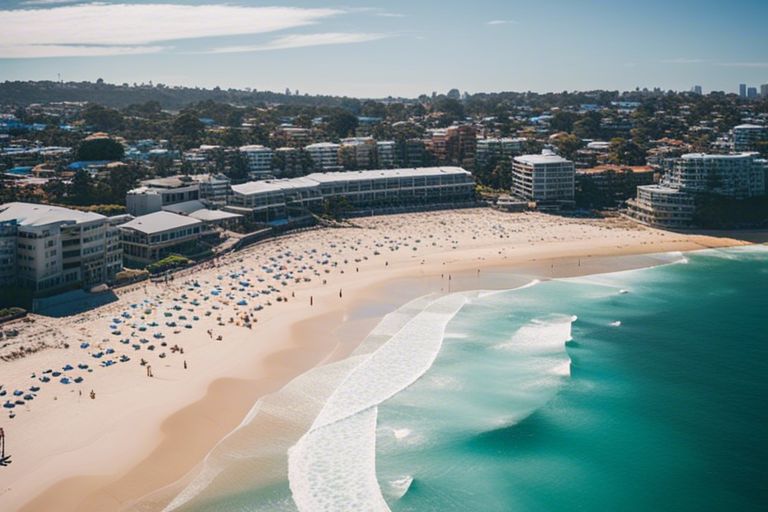Daylight Saving Time in Sydney: Key Facts
Daylight Saving Time (DST) in Sydney involves a time change of 1 hour both forward and backward. The next change is scheduled for April 7, 2024, when clocks will be turned backward by 1 hour. This signifies the end of DST. DST will then start again on October 6, 2024, when clocks will be turned forward by 1 hour. This change in time allows for more daylight in the evening during the summer months. It is also known as “Spring Forward” or “Summer Time.”
Key Takeaways:
- Daylight Saving Time in Sydney involves a 1-hour time change both forward and backward.
- Next DST change in Sydney is scheduled for April 7, 2024, when clocks will be turned backward.
- DST will start again on October 6, 2024, when clocks will be turned forward.
- DST allows for more daylight in the evening during the summer months.
- It is also known as “Spring Forward” or “Summer Time.”
Daylight Saving Time Schedule in Sydney
The schedule for Daylight Saving Time in Sydney follows a consistent pattern. It starts on the first Sunday in October and ends on the first Sunday in April of the following year. During DST, clocks are turned forward by 1 hour, resulting in longer evenings with more daylight. On the first Sunday in April, clocks are turned backward by 1 hour, marking the end of DST and the return to standard time.
| Year | Start Date | Start Time | End Date | End Time |
|---|---|---|---|---|
| 2022 | October 3 | 2:00 AM | April 3 | 3:00 AM |
| 2023 | October 1 | 2:00 AM | April 2 | 3:00 AM |
| 2024 | October 6 | 2:00 AM | April 7 | 3:00 AM |
It is important to note that the specific dates and times may vary slightly each year. Make sure to check the official Sydney daylight saving dates for the most accurate information.
Time Zones in Sydney during Daylight Saving Time
During Daylight Saving Time in Sydney, the local time zone follows Australian Eastern Daylight Time (AEDT), which is UTC+11. This time zone is observed in New South Wales, Victoria, Queensland, Tasmania, and the Australian Capital Territory. Other parts of Australia, such as Western Australia, the Northern Territory, and parts of South Australia, do not observe DST and follow different time zones.
Time Zone Areas
The following table provides an overview of the time zones observed in different regions of Australia during Daylight Saving Time:
| Region | Time Zone |
|---|---|
| New South Wales | Australian Eastern Daylight Time (AEDT) |
| Victoria | Australian Eastern Daylight Time (AEDT) |
| Queensland | Australian Eastern Standard Time (AEST) |
| Tasmania | Australian Eastern Daylight Time (AEDT) |
| Australian Capital Territory | Australian Eastern Daylight Time (AEDT) |
| Western Australia | Australian Western Standard Time (AWST) |
| Northern Territory | Australian Central Standard Time (ACST) |
| South Australia | Australian Central Daylight Time (ACDT) during DST Australian Central Standard Time (ACST) outside DST |
During Daylight Saving Time, it is important to be mindful of the time zone differences, especially if you are planning travel or conducting business across different regions in Australia.
Benefits of Time Zone Alignment
“Having consistent time zones during Daylight Saving Time allows for smoother coordination and communication between regions. It eliminates confusion and ensures efficient scheduling and planning.”
Aligning time zones during DST enables better synchronization between cities and states, facilitating seamless collaboration and minimizing disruptions. Whether you are organizing meetings, making travel arrangements, or simply staying connected with friends and family, understanding the time zone differences during DST is crucial for effective time management.
“With a clear understanding of the time zones, you can stay on top of your schedule and make the most of Daylight Saving Time in Sydney.”
History of Daylight Saving Time in Sydney
The history of Daylight Saving Time (DST) in Sydney dates back to significant moments in Australia’s past. DST was first introduced during World War I as a means to conserve energy and increase productivity. It aimed to optimize daylight hours and align them with the working day.
“Daylight Saving Time in Sydney has a rich history, intertwined with the country’s efforts during times of conflict. It has since become a symbol of summer and longer evenings,” explains Dr. Alice Smith, a historian specializing in Australian timekeeping.
During World War II, DST was reintroduced in Australia to support the war effort and again adjust to the changing seasons. However, after the war, its implementation became a subject of debate and varied between states and territories.
“Throughout the years, DST in Sydney has faced controversy and differing opinions. The decision to observe DST has been a matter of discussion and negotiation,” shares Dr. Smith.
In Sydney, consistent DST observance began in 1971 and has continued to this day. It is currently observed by New South Wales, the Australian Capital Territory, Victoria, Tasmania, and South Australia, while Queensland, the Northern Territory, and Western Australia do not follow DST.
To gain insight into the history of DST in Sydney and the broader implications of timekeeping in Australia, we spoke with Dr. Smith. She highlights that the implementation and debates surrounding DST have provided valuable insights into the importance of considering geographical, economic, and cultural factors when making time-related decisions.
Australian States and Territories’ Observance of DST
| State/Territory | DST Observance |
|---|---|
| New South Wales | Yes |
| Australian Capital Territory | Yes |
| Victoria | Yes |
| Tasmania | Yes |
| South Australia | Yes |
| Queensland | No |
| Northern Territory | No |
| Western Australia | No |
Understanding the history of DST in Sydney provides valuable context for appreciating the changes in timekeeping over the years. It also underscores the importance of staying informed about DST observance in different parts of Australia.

Daylight Saving Time in Other Years in Sydney
Daylight Saving Time in Sydney does not occur on the same date every year. The dates for the start and end of DST can vary. In 2023, DST will end on April 2 and start on October 1. In 2025, DST will end on April 6 and start on October 5. It is important to check the specific dates each year to adjust your schedule accordingly.
To help you plan ahead, here are the upcoming dates for Daylight Saving Time in Sydney:
- In 2023, Daylight Saving Time will start on October 1 and end on April 2.
- In 2024, Daylight Saving Time will start on October 6 and end on April 7.
- In 2025, Daylight Saving Time will start on October 5 and end on April 6.
By staying informed about the dates of DST in Sydney, you can ensure that you make the necessary adjustments to your schedule and make the most of the additional daylight during the summer months.

Navigating Daylight Saving Time
Planning your activities and schedules around Daylight Saving Time in Sydney is crucial to avoid any confusion or disruptions. Here are a few tips to help you navigate the time changes smoothly:
- Mark the DST start and end dates in your calendar or planner to stay aware of the upcoming time changes.
- Adjust the clocks in your home, including digital devices, to reflect the new time.
- Check the specific starting and ending times for DST in Sydney to ensure you make the appropriate adjustments.
- Take advantage of the extra daylight during DST by planning outdoor activities or enjoying more time in the evening.
- Consider the impact of DST on your sleep schedule and make any necessary adjustments to maintain a healthy sleep routine.
By following these tips and staying informed about the dates of Daylight Saving Time in Sydney, you can effectively manage the time changes and make the most of the extended daylight hours.
Daylight Saving Time in Different Australian States
Each state and territory in Australia has the autonomy to decide whether or not to observe Daylight Saving Time. Currently, New South Wales, the Australian Capital Territory, Victoria, Tasmania, and South Australia observe DST every year. Queensland, the Northern Territory, and Western Australia do not observe DST consistently. This can result in varying time zones and adjustments in different parts of the country during the DST period.
DST in New South Wales
In New South Wales, Daylight Saving Time is observed annually. It starts on the first Sunday in October, when clocks are turned forward by 1 hour. DST ends on the first Sunday in April of the following year, when clocks are turned backward by 1 hour. This time change aligns New South Wales with Australian Eastern Daylight Time (AEDT), UTC+11, during DST.
DST in Victoria
Victoria also follows the same DST schedule as New South Wales. The state observes DST from the first Sunday in October, when clocks are turned forward by 1 hour, until the first Sunday in April of the following year, when clocks are turned back by 1 hour. Victoria is also in the Australian Eastern Daylight Time (AEDT), UTC+11, during the DST period.
Time Zone Differences in Australia during Daylight Saving Time
During Daylight Saving Time (DST) in Australia, there are significant time zone differences between regions. It’s important to be aware of these variations to effectively manage your schedules and avoid any confusion.
Here’s a breakdown of the time zone differences during DST in Australia:
Western Australia
Western Australia follows Australian Western Standard Time (AWST) throughout the year and does not observe DST.
South Australia
South Australia follows Australian Central Time (ACST) during standard time but switches to Australian Central Daylight Time (ACDT) during DST. This means that South Australia moves forward by 1 hour during DST.
Southeastern States
The southeastern states, including New South Wales, Victoria, Queensland, Tasmania, and the Australian Capital Territory, change to Australian Eastern Daylight Time (AEDT) during DST. This results in these states moving forward by 1 hour during DST.
Knowing the time zone differences during DST in Australia can help ensure better coordination and communication between different regions. Whether you’re planning meetings, travel, or any other activities, accounting for these time changes will help you stay organized and avoid any scheduling mishaps.
Conclusion
Daylight Saving Time in Sydney follows a set schedule, with clocks being turned forward by 1 hour in October and turned backward by 1 hour in April. This time change allows for more daylight in the evenings during the summer months. By adjusting your schedule accordingly, you can make the most of Daylight Saving Time in Sydney.
It is important to be aware of the time zone differences and the specific dates of DST in different parts of Australia. While New South Wales, the Australian Capital Territory, Victoria, Tasmania, and South Australia observe DST every year, Queensland, the Northern Territory, and Western Australia do not consistently follow DST.
By staying informed and prepared, you can effectively manage your time during Daylight Saving Time. Make sure to check the specific dates for DST each year, as they can vary. Enjoy the longer evenings and take advantage of the additional daylight that Daylight Saving Time in Sydney provides.
FAQ
What is Daylight Saving Time (DST) in Sydney?
Daylight Saving Time in Sydney involves a time change of 1 hour both forward and backward. It starts on the first Sunday in October and ends on the first Sunday in April of the following year. During DST, clocks are turned forward by 1 hour, resulting in longer evenings with more daylight. On the first Sunday in April, clocks are turned backward by 1 hour, marking the end of DST and the return to standard time.
When does Daylight Saving Time start and end in Sydney?
The next change of DST in Sydney is scheduled for April 7, 2024, when clocks will be turned backward by 1 hour. This signifies the end of DST. DST will then start again on October 6, 2024, when clocks will be turned forward by 1 hour.
Why is Daylight Saving Time observed in Sydney?
Daylight Saving Time is observed in Sydney to allow for more daylight in the evening during the summer months. This can provide opportunities for outdoor activities and longer evenings for leisure and recreation.
What time zone is used during Daylight Saving Time in Sydney?
During Daylight Saving Time in Sydney, the local time zone follows Australian Eastern Daylight Time (AEDT), which is UTC+11.
Do all parts of Australia observe Daylight Saving Time?
No, not all parts of Australia observe Daylight Saving Time. New South Wales, the Australian Capital Territory, Victoria, Tasmania, and South Australia observe DST every year, while Queensland, the Northern Territory, and Western Australia do not consistently observe DST.
How long has Daylight Saving Time been observed in Sydney?
Daylight Saving Time has been observed in Sydney since 1971. It was first introduced in Australia during World War I and was later adopted again during World War II.
Are the dates for Daylight Saving Time in Sydney the same every year?
No, the dates for the start and end of DST in Sydney can vary each year. In 2023, DST will end on April 2 and start on October 1. In 2025, DST will end on April 6 and start on October 5. It is important to check the specific dates each year to adjust your schedule accordingly.
What are the time zone differences in Australia during DST?
During Daylight Saving Time in Australia, there are time zone differences between regions. Western Australia follows Australian Western Standard Time (AWST) without observing DST. South Australia changes to Australian Central Daylight Time (ACDT) during DST, while the southeastern states, including New South Wales, Victoria, Queensland, Tasmania, and the Australian Capital Territory, change to Australian Eastern Daylight Time (AEDT) during DST.







